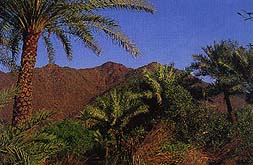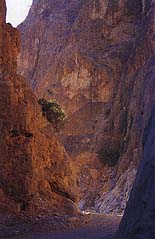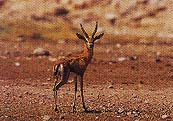Wildlife and Environment of the United Arab Emirates
Pictures by Hanne & Jens Eriksen, Hornby
For the Arabs of the UAE, the desert, mountains and seas have long provided raw materials for building homes or constructing sailing craft, as well as a sustainable source of food on which they have depended for their very survival. Given the relative sparcity of life in the desert, and the unpredictability of life-giving rain, it is hardly surprising that conservation has been at the very core of man's existence in this part of Arabia. Add to this the fact that Islam calls upon its followers to treat all creatures with deep respect, and you may begin to appreciate why wildlife, the environment and conservation are given such a high priority in a land where the rapid pace of development brings potential conflicts between man and nature into sharp focus.
 When the British explorer Wilfred Thesiger was completing his own epic journey across the Empty Quarter in the early 1950s, as he so vividly describes in his book Arabian Sands, he went to stay with Sheikh Zayed, who lived at that time in the Al-Ain/Buraimi oasis. His first meeting with the man who was to become ruler of Abu Dhabi and President of the United Arab Emirates took place in humble, natural surroundings. Zayed was sitting on the ground under an acacia tree outside the fort. Thesiger recalls: 'He was a powerfully built man of about thirty with a brown beard. He had a strong intelligent face, with steady, observant eyes and his manner was quiet but masterful......He wore a dagger and a cartridge belt; his rifle lay on the sand beside him.' Thesiger commented that the locals held Zayed in great respect for he was a true bedouin with all the local knowledge of the desert and wildlife that the word implied.
When the British explorer Wilfred Thesiger was completing his own epic journey across the Empty Quarter in the early 1950s, as he so vividly describes in his book Arabian Sands, he went to stay with Sheikh Zayed, who lived at that time in the Al-Ain/Buraimi oasis. His first meeting with the man who was to become ruler of Abu Dhabi and President of the United Arab Emirates took place in humble, natural surroundings. Zayed was sitting on the ground under an acacia tree outside the fort. Thesiger recalls: 'He was a powerfully built man of about thirty with a brown beard. He had a strong intelligent face, with steady, observant eyes and his manner was quiet but masterful......He wore a dagger and a cartridge belt; his rifle lay on the sand beside him.' Thesiger commented that the locals held Zayed in great respect for he was a true bedouin with all the local knowledge of the desert and wildlife that the word implied.
Thesiger and his colleagues spent a month as Zayed's guest and during the visit they went hunting together with falcons. On one occasion a falcon took off across the sand-hills and was eventually discovered by Zayed and Thesiger who were on camel-back. After recovering the bird Zayed pointed to some oily splashes on the ground, explaining to Thesiger that the houbara bustard squirts this secretion at an attacking falcon, temporarily blinding the predator. Thesiger goes on to describe encounter after encounter in which Zayed quietly imparted his understanding of nature and his love of wildlife. The experience made a powerful impression on the British explorer and is beautifully recounted in his classic book.
In this year of triple celebrations for the UAE - 25 years of federation; 25 years of Sheikh Zayed's Presidency and 30 years of his rule over the emirate of Abu Dhabi, there has been great interest in retrospective analysis of what the last quarter century has meant for the seven emirates that comprise the UAE. It is clear from such analysis that its people have benefited significantly from the efforts of a government committed to social development and improvement of facilities in virtually every aspect of their lives. However, one could easily argue that, given the country's vast oil wealth, it would have been inconceivable that this would not be the case. The fact that this development has taken place in an atmosphere of respect for its cultural heritage, and with a committed acknowledgement of the need to conserve its natural world, is perhaps more impressive than the infrastructural and socio-economic strides which have transformed the nation.
 The challenge of maintaining a balance between man and the environment has been central to Sheikh Zayed's entire period of stewardship. His conviction that the deserts can be turned green again, as they once were before climate changed to one of the driest on the globe, has led him to support a massive campaign of afforestation and irrigation, utilizing waste water from urban and industrial developments to make grass, crops and trees grow in place of shifting sands. The results of this sustained endeavour are particularly apparent as one flies into the UAE, hardly failing to observe from the air that vast tracts of previously arid desert are now forested - more than 130 million trees having been planted during the past 25 years. On the ground, as one drives from airport to city centre, the solid greenery of tree-lined freeways reinforces an impression of lush tropical vegetation rather than arid desert, and even in the urban heartlands of Abu Dhabi and Dubai one can hardly fail to be impressed by the carefully cultivated parklands which have become a magnet for migrating birds and other native wildlife.
The challenge of maintaining a balance between man and the environment has been central to Sheikh Zayed's entire period of stewardship. His conviction that the deserts can be turned green again, as they once were before climate changed to one of the driest on the globe, has led him to support a massive campaign of afforestation and irrigation, utilizing waste water from urban and industrial developments to make grass, crops and trees grow in place of shifting sands. The results of this sustained endeavour are particularly apparent as one flies into the UAE, hardly failing to observe from the air that vast tracts of previously arid desert are now forested - more than 130 million trees having been planted during the past 25 years. On the ground, as one drives from airport to city centre, the solid greenery of tree-lined freeways reinforces an impression of lush tropical vegetation rather than arid desert, and even in the urban heartlands of Abu Dhabi and Dubai one can hardly fail to be impressed by the carefully cultivated parklands which have become a magnet for migrating birds and other native wildlife.
But what of the natural Emirates, that land beyond city and highway, far from the sight of high-rise buildings and the noise of vehicles? Is there anything left of the Arabia that once existed, before oil was discovered and before Zayed and his people decided to build a modern, developed country? Can it be true that leopards still live among the mountains, or that the Arabian tahr, until recently thought to be extinct in the UAE, still survives in isolated 'hidden' valleys, or indeed that the elusive sea-cow or dugong still swims among its sheltered offshore islands? Just how successful has this Arabian country been at balancing the demands of man against those of wildlife?
Natural Emirates, published by Trident Press as part of the UAE's Silver Jubilee celebrations, addresses such questions directly in a series of well informed, beautifully illustrated chapters on the UAE's wildlife, written by experts in their individual fields. You will be relieved to read that leopards do indeed still live in the UAE, in larger numbers than were previously estimated, but still not sufficient to ensure their future survival. Protection of the leopard has provided a rallying call for a grass-roots conservation programme spearheaded by the Arabian Leopard Trust which has established a captive breeding pair of leopards in the UAE and is working towards creation of a reserve for their protection in the wild.
After a carcass of a tahr was found near a water pool on Jebel Hafit in 1982, it was generally thought that the tahr was extinct outside of Oman. That remained the view until a 1995 survey of possible leopard habitats undertaken by Chris and Tilde Stuart, and organized by the Arabian Leopard Trust. The Stuarts are knowledgeable trackers and naturalists who have honed their skills over many years of fieldwork in Africa, Arabia and in other regions. Whilst clambering along a ledge in the Shimailiyyah mountains of the UAE their attention was drawn by the sound of a falling pebble on the opposite side of the ravine. Not only did they catch sight of an adult and young tahr, but they also took the first ever photographs of live tahr in the Emirates. Seen against the dark purplish rocks, the tahr were almost invisible. Reproduced in Natural Emirates, this picture seems to speak out from the page. The adult tahr, facing the camera, appeals to us all to respect the wilderness in which it still survives.
Dugongs have been hunted in this region for thousands of years, as evidenced by the presence of their skeletal remains in ancient middens and at burial sites. Dugongs in the UAE mostly inhabit the shallow waters around the islands of Murawah and Bu Tina to the west of Abu Dhabi, but their range extends further west to the border of Qatar and beyond, and there are still occasional sightings to the east around Jebel Ali, Umm al-Qaiwain and Ras al-Khaimah. The UAE's rich and extensive seagrass beds are vital to the continued survival of this sea-mammal in the Gulf region. Natural Emirates not only provides us with data on the survival of dugongs in the UAE but also backs it up with some rare photographs of them taken during a marine survey of Abu Dhabi's offshore waters.
 As one turns the pages of Natural Emirates it is hard to be unimpressed by the sheer variety of wildlife that the country supports. Despite the demands of industrial and infrastructural development, habitats have been preserved and nature has been respected to a far greater extent than one finds in many other countries. Whilst the mangrove has often been regarded as an annoying encumberance, fair game for removal or infilling of its shallow habitat, in the Emirates large areas of mangrove have not only been preserved but fresh stands are constantly being planted, creating new habitats for marine life and for many birds and other animals. Meanwhile, the UAE's oldest mangroves, at Khor Kalba on the east coast, remain home of the endemic sub-species of white-collared kingfisher (Halcyon chloris kalbaensis,) one of the rarest birds in the world.
As one turns the pages of Natural Emirates it is hard to be unimpressed by the sheer variety of wildlife that the country supports. Despite the demands of industrial and infrastructural development, habitats have been preserved and nature has been respected to a far greater extent than one finds in many other countries. Whilst the mangrove has often been regarded as an annoying encumberance, fair game for removal or infilling of its shallow habitat, in the Emirates large areas of mangrove have not only been preserved but fresh stands are constantly being planted, creating new habitats for marine life and for many birds and other animals. Meanwhile, the UAE's oldest mangroves, at Khor Kalba on the east coast, remain home of the endemic sub-species of white-collared kingfisher (Halcyon chloris kalbaensis,) one of the rarest birds in the world.
Whilst no single book can cover the entire subject of the UAE's natural world, Natural Emirates makes a bold attempt to present a balanced picture of what is to be found there, offering as much information on insects and reptiles, for example as for the more popular birds and mammals. Chapters on geology and palaeontology are refreshingly written for the general reader whilst retaining their scientific accuracy and the chapter on plantlife is compiled more with a view to encouraging the amateur naturalist to explore the wonders of local flora than to provide a blow by blow taxonomic account of individual species.
Above all however, this book is a visual celebration of a segment of Arabia's natural world that has received relatively little media attention in the past, but which clearly merits a much greater focus in future. Award winning photographers, Jens and Hanne Eriksen were especially commissioned to photograph for the book. In addition many of the authors have contributed their own unique UAE wildlife photographs, covering subjects as diverse as snakes shedding their skin to sperm whales breaching, and you have a book that will not only impress its readers but which will play a positive role in supporting the conservation of the UAE's natural world for future generations to experience and enjoy.
Web Links | Subjects | Search
Arabian Wildlife. Volume 3, Number 1